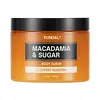What's inside
What's inside
 Key Ingredients
Key Ingredients

 Benefits
Benefits

 Concerns
Concerns

 Ingredients Side-by-side
Ingredients Side-by-side

Water
Skin ConditioningHydrated Silica
AbrasiveCetearyl Alcohol
EmollientIsopropyl Palmitate
EmollientGlyceryl Stearate Se
EmulsifyingStearic Acid
CleansingPhenoxyethanol
PreservativeParfum
MaskingButyrospermum Parkii Butter
Skin ConditioningCarbomer
Emulsion StabilisingCocos Nucifera Shell Powder
AbrasiveEthylhexylglycerin
Skin ConditioningSodium Hydroxide
BufferingCI 16035
Cosmetic ColorantCI 17200
Cosmetic ColorantSucrose
HumectantGlycerin
HumectantC12-14 Alketh-12
EmulsifyingSilica
AbrasiveWater
Skin ConditioningMacadamia Ternifolia Seed Extract
EmollientButyrospermum Parkii Butter
Skin ConditioningHydroxyacetophenone
AntioxidantDipropylene Glycol
HumectantPrunus Armeniaca Seed Powder
AbrasiveCaprylyl Glycol
EmollientPolyacrylate Crosspolymer-6
Emulsion StabilisingPersea Gratissima Oil
Skin Conditioning1,2-Hexanediol
Skin ConditioningMacadamia Integrifolia Seed Oil
Skin ConditioningHibiscus Sabdariffa Flower Extract
Skin ConditioningButylene Glycol
HumectantT-Butyl Alcohol
PerfumingVaccinium Angustifolium Fruit Extract
Skin ProtectingRubus Fruticosus Fruit Extract
AstringentEuterpe Oleracea Fruit Extract
Vaccinium Myrtillus Fruit Extract
Skin ConditioningVaccinium Macrocarpon Fruit Extract
AstringentRubus Idaeus Fruit Extract
AstringentPhyllanthus Emblica Extract
Skin ConditioningFragaria Vesca Leaf Extract
AstringentFragaria Chiloensis Fruit Extract
Skin ConditioningDipotassium Glycyrrhizate
HumectantPunica Granatum Fruit Extract
AntioxidantMorus Alba Fruit Extract
AntioxidantGinkgo Biloba Nut Extract
Skin ConditioningFicus Carica Fruit Extract
HumectantParfum
MaskingBenzyl Benzoate
AntimicrobialCitronellol
PerfumingLimonene
PerfumingHexyl Cinnamal
PerfumingLinalool
PerfumingSucrose, Glycerin, C12-14 Alketh-12, Silica, Water, Macadamia Ternifolia Seed Extract, Butyrospermum Parkii Butter, Hydroxyacetophenone, Dipropylene Glycol, Prunus Armeniaca Seed Powder, Caprylyl Glycol, Polyacrylate Crosspolymer-6, Persea Gratissima Oil, 1,2-Hexanediol, Macadamia Integrifolia Seed Oil, Hibiscus Sabdariffa Flower Extract, Butylene Glycol, T-Butyl Alcohol, Vaccinium Angustifolium Fruit Extract, Rubus Fruticosus Fruit Extract, Euterpe Oleracea Fruit Extract, Vaccinium Myrtillus Fruit Extract, Vaccinium Macrocarpon Fruit Extract, Rubus Idaeus Fruit Extract, Phyllanthus Emblica Extract, Fragaria Vesca Leaf Extract, Fragaria Chiloensis Fruit Extract, Dipotassium Glycyrrhizate, Punica Granatum Fruit Extract, Morus Alba Fruit Extract, Ginkgo Biloba Nut Extract, Ficus Carica Fruit Extract, Parfum, Benzyl Benzoate, Citronellol, Limonene, Hexyl Cinnamal, Linalool
Ingredients Explained
These ingredients are found in both products.
Ingredients higher up in an ingredient list are typically present in a larger amount.
This ingredient is also known as shea butter. It is an effective skin hydrator and emollient.
Emollients help soothe and soften your skin. It does this by creating a protective film on your skin. This barrier helps trap moisture and keeps your skin hydrated. Emollients may be effective at treating dry or itchy skin.
Shea butter is rich in antioxidants. Antioxidants help fight free-radicals, or molecules that may harm the body. It is also full of fatty acids including stearic acid and linoleic acid. These acids help replenish the skin and keep skin moisturized.
While Shea Butter has an SPF rating of about 3-4, it is not a sunscreen replacement.
Shea butter may not be fungal acne safe. We recommend speaking with a professional if you have any concerns.
Learn more about Butyrospermum Parkii ButterParfum is a catch-all term for an ingredient or more that is used to give a scent to products.
Also called "fragrance", this ingredient can be a blend of hundreds of chemicals or plant oils. This means every product with "fragrance" or "parfum" in the ingredients list is a different mixture.
For instance, Habanolide is a proprietary trade name for a specific aroma chemical. When used as a fragrance ingredient in cosmetics, most aroma chemicals fall under the broad labeling category of “FRAGRANCE” or “PARFUM” according to EU and US regulations.
The term 'parfum' or 'fragrance' is not regulated in many countries. In many cases, it is up to the brand to define this term.
For instance, many brands choose to label themselves as "fragrance-free" because they are not using synthetic fragrances. However, their products may still contain ingredients such as essential oils that are considered a fragrance by INCI standards.
One example is Calendula flower extract. Calendula is an essential oil that still imparts a scent or 'fragrance'.
Depending on the blend, the ingredients in the mixture can cause allergies and sensitivities on the skin. Some ingredients that are known EU allergens include linalool and citronellol.
Parfum can also be used to mask or cover an unpleasant scent.
The bottom line is: not all fragrances/parfum/ingredients are created equally. If you are worried about fragrances, we recommend taking a closer look at an ingredient. And of course, we always recommend speaking with a professional.
Learn more about ParfumWater. It's the most common cosmetic ingredient of all. You'll usually see it at the top of ingredient lists, meaning that it makes up the largest part of the product.
So why is it so popular? Water most often acts as a solvent - this means that it helps dissolve other ingredients into the formulation.
You'll also recognize water as that liquid we all need to stay alive. If you see this, drink a glass of water. Stay hydrated!
Learn more about Water